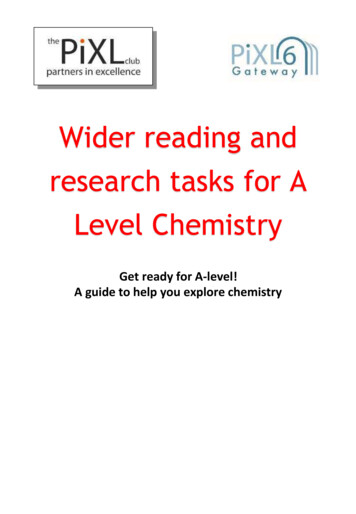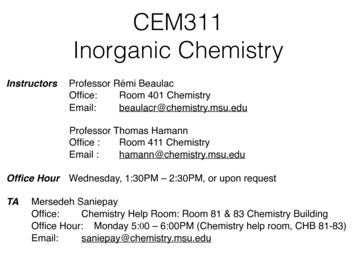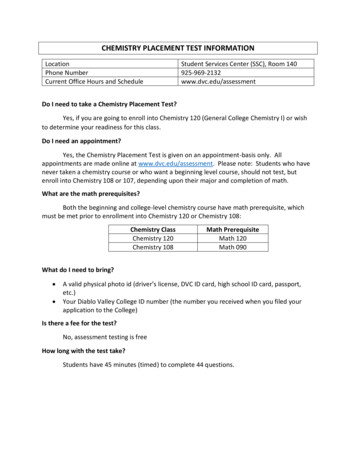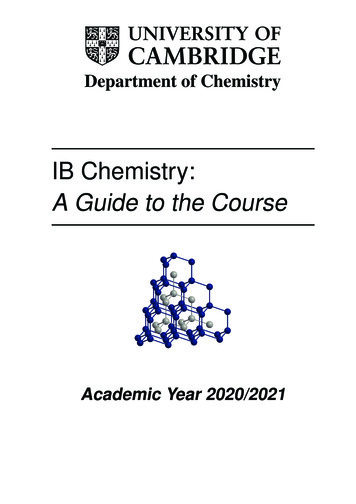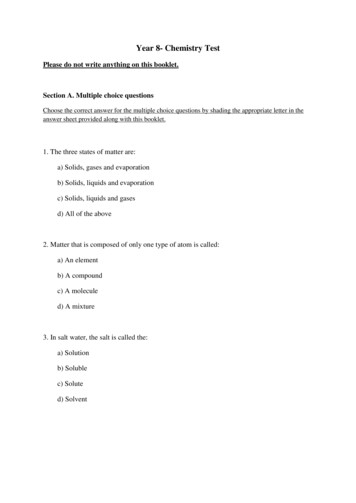
Transcription
Year 8- Chemistry TestPlease do not write anything on this booklet.Section A. Multiple choice questionsChoose the correct answer for the multiple choice questions by shading the appropriate letter in theanswer sheet provided along with this booklet.1. The three states of matter are:a) Solids, gases and evaporationb) Solids, liquids and evaporationc) Solids, liquids and gasesd) All of the above2. Matter that is composed of only one type of atom is called:a) An elementb) A compoundc) A moleculed) A mixture3. In salt water, the salt is called the:a) Solutionb) Solublec) Soluted) Solvent
4. When sugar dissolves in water, the water is called the:a) Solutionb) Solublec) Soluted) Solvent5. Which separation technique is most suitable to separate salt from water?a) Evaporationb) Filtrationc) Using a magnetd) Decantation6. Density is a(n):a) chemical propertyb) compoundc) elementd) physical property7. If ice is heated until it is changed into water vapour (gas), the phase changes which haveoccurred are:a) melting and evaporationb) condensation and meltingc) freezing and evaporationd) condensation and freezing
8. If oil is mixed with water, the mixture will eventually separate into two separate layerswith oil on top and water below. The best explanation of why oil forms the top layer andwater forms the bottom layer is:a) Oil is less dense than waterb) Water is less dense than oilc) Gravity pulls the water down but has no effect on oild) It was pure chance that oil formed the top layer9. What are the reactant(s) in the following chemical reaction?2H2O2 2H2O O2a) H2O O2b) H Oc) H2 O2d) H2O210. Thermal expansion occurs when a substance is:a) cooledb) heatedc) compressedd) stretched11. If pure baking soda is a compound, then it is certain that baking soda:a) contains some oxygen combined with other elementsb) contains more than one element chemically bound to each otherc) could be physically changed into elements and compoundsd) is a simple mixture of elements
12. A solute may be recovered from a solution by:a) sublimationb) filtrationc) evaporationd) decantationThe table below shows an unknown solid dissolved in some liquids.LiquidNumber of teaspoons of solid dissolvedWater2Petrol5Alcohol7Kerosene313. The solid was least soluble in:a) waterb) petrolc) alcohold) kerosene14. The solid was most soluble in:a) waterb) petrolc) alcohold) kerosene
15. All atoms are made up of:a) protons, molecules and mixturesb) protons, neutrons and electronsc) electrons, compounds and neutronsd) electrons, protons and compounds16. Out of the following lists of substances, which list contains all compounds:a) Ca, H2 and NaClb) H2, He2 and Ar2c) H2O, CO2, NaCld) Hydrogen gas, oxygen gas and carbonQuestion 17 and 18 are based on the following information.Sand and salt were placed in a beaker of water. The salt dissolved and the sand sank to thebottom.17. Based on the above information salt is:a) insolubleb) a solventc) an elementd) soluble18. Based on the above information the sand is:a) insolubleb) a solventc) an elementd) soluble
19. A rock such as granite could be classified as a mixture because it:a) has only one kind of atomb) consists of more than one type of atom chemically combinedc) may be broken down into separate compounds by physical meansd) may be separated into separate compounds by chemical processes20. Which of the following diagrams best shows filtration?a) Ab) Bc) Cd) D
ChemistrySection B: Answer sheet1. Give the chemical symbol for each of the elements listed below. (3 marks)a) Calciumb) Berylliumc) Phosphorousd) Sodiume) Potassiumf) Chlorine2. State whether each of the following changes is physical (P) or chemical (C): (3 marks)a) An ice block meltingb) The rusting of ironc) The burning of woodd) The souring of milke) Sublimation of dry icef) Trimming a hedge3. State whether the following are an element (E), Compound (C) or mixture (M): (4 marks)a) H2Ob) H2c) Salt (NaCl)d) A caesar salade) Calciumf) CO2g) Sugar dissolved in waterh) HCl
4. Explain your understanding of the ‘Kinetic Theory’. Be sure to include and explain theterms ‘thermal expansion’ and ‘thermal contraction’ with reference to the kinetic theory. (3marks)5. Give the definition for the following terms: (5 marks)a) Massb) Volumec) Densityd) Atome) Molecule
6. Appropriately label the following diagram with these terms: (3 marks)Sublimation, condensation, solidification, deposition, evaporation, meltingInsert particle diagram
7. Read the following experiment carefully and answer the following questions.A group of year eight students undertook an experiment involving placing a small piece ofmagnesium metal into hydrochloric acid. The students measured the temperature of theHydrochloric acid before the experiment and at 1 minute intervals for 5 minutes. Theytabulated their results as shown in the table below. They also recorded their observations andthese are also shown below.Time(minutes)Temperature(c )Observations:0120302353438536286789262524231022- the reaction produced heat-a popping sound was heard when a flame was placed near the beaker-the magnesium was shinier-bubblinga) Plot the results on the graph paper provided (4 marks)The equation of this reaction is as follows:2Mg 2HCl 2MgCl H2b) What are the reactants in this reaction? (1 mark)c) What are the products in this reaction? (1 mark)d) Is this a physical or chemical reaction? (1 mark)e) Give reasons/evidence for answer (d) above. (2 marks)END OF TEST
Year 8Chemistry Science TestName:Section A: Multiple Choice AnswersPut a cross (X) through the correct 18abcd19abcd20abcdMarksMultiple ChoiceShort AnswersTotal/20/30/50/20/30/50
15. All atoms are made up of: a) protons, molecules and mixtures b) protons, neutrons and electrons c) electrons, compounds and neutrons d) electrons, protons and compounds


